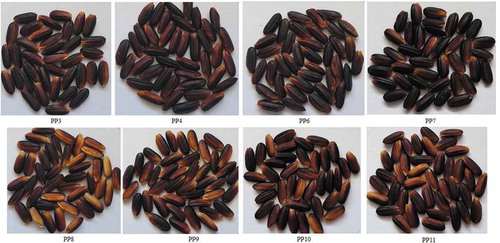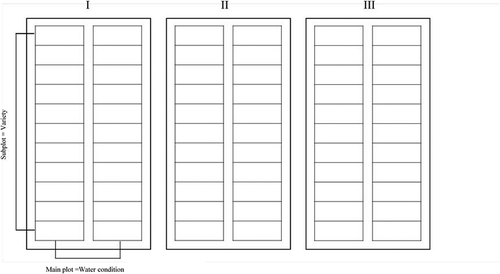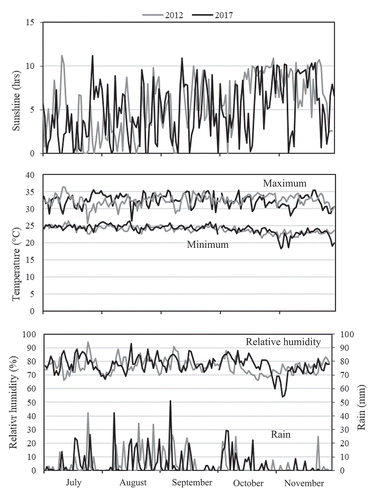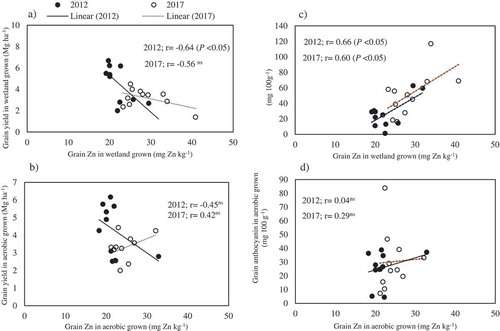 ?Mathematical formulae have been encoded as MathML and are displayed in this HTML version using MathJax in order to improve their display. Uncheck the box to turn MathJax off. This feature requires Javascript. Click on a formula to zoom.
?Mathematical formulae have been encoded as MathML and are displayed in this HTML version using MathJax in order to improve their display. Uncheck the box to turn MathJax off. This feature requires Javascript. Click on a formula to zoom.ABSTRACT
This study evaluated grain anthocyanin, zinc (Zn) and iron (Fe) concentrations, and grain yield of eleven purple rice varieties (PP1–PP11) grown under wetland (W+) and aerobic conditions (W0) in 2 years. There was a significant variation in the concentrations of anthocyanin, Zn and Fe, by water regime and year among the varieties with a wide range of anthocyanin (1–117 mg 100 g−1) and narrower ranges of Zn (19–41 mg kg−1) and Fe (6–19 mg kg−1) concentrations. The nutritional quality in aerobic grown rice was lower than wetland grown among the varieties with higher levels of anthocyanin (>40 mg 100 g−1), Zn (>30 mg kg−1) and Fe (>15 mg kg−1), with smaller effects of water among varieties in the lower quality ranges. The lowering of anthocyanin in aerobic grown rice was observed in the two varieties of the upland ecotype that were highest in anthocyanin concentration, as well as some wetland varieties. The grain yield (1.4–6.7 Mg ha−1) was associated negatively with grain Zn concentration (r = −0.50, P ≤ 0.001), but not with grain Fe (r = −0.14, NS0.05) or anthocyanin (r = −0.27, NS0.05). The anthocyanin concentration in the purple rice increased with Zn concentration (r = 0.57, P ≤ 0.001). Wetland condition was shown to be more favorable than aerobic culture for intense pigmentation in the production of purple rice, as well as higher Zn and Fe concentrations.
ABSTRACT
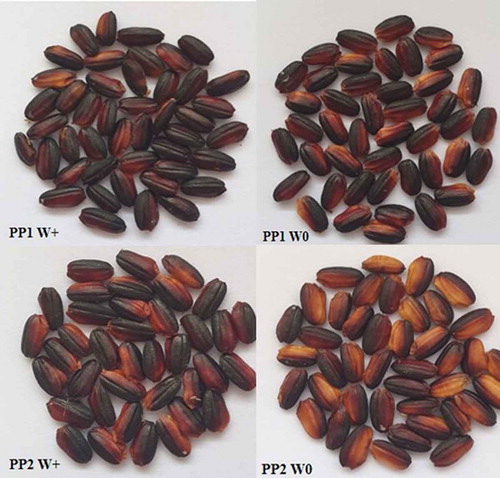
Introduction
Anthocyanin compounds are the pigmented flavonoid component responsible for the purple pericarp color in some rice varieties recognized as one of the major bioactive compounds in unpolished or brown rice (Deng et al., Citation2013). The compound plays an important role in promoting the consumer’s health, including prevention of cancer, diabetes, neuronal and cardiovascular diseases, and improvement of eyesight (Hu et al., Citation2003; Konczak & Zhang, Citation2004; Tanaka et al., Citation2011). Consumption of purple rice pericarp as a supplement was reported to inhibit atherosclerotic plaque formation in mice more strongly than the polishing from non-pigmented white rice, due to the reduction of cholesterol accumulation, oxidative stress and inflammation (Xia et al., Citation2003).
A wide genotypic variation in grain anthocyanin accumulation has been reported among the rice germplasm from different countries (Chen et al., Citation2012; Pereira-Caro et al., Citation2013; Sompong et al., Citation2011). For example, anthocyanin in different purple rice varieties collected from southern Thailand was reported to range from 9.8 to 245.4 mg 100 g−1 (Yodmanee et al., Citation2011). Higher concentrations of phenolic acids, flavonoids and antioxidant capacity were detected in rice with purple pericarp than those with red or white pericarp (Pengkumsri et al., Citation2015; Vichapong et al., Citation2010; Zhang et al., Citation2010). Moreover, purple rice possesses the wide range of numerous nutritional qualities in grain such as K, Fe, Zn, Cu, Mg, Mn and P (Ito & Lacerda, Citation2019). Genotypic variation has been reported among the local purple rice varieties from northern Thailand grown by the local farmers and is generally consumed as unpolished rice with pericarp intact without polishing process (Moonnilta, Citation2010). It is used in traditional ceremonies for preparation of deserts and special foods with believing that it contains medicinal properties such as stop bleeding after childbirth, bringing down fever to curing skin disease and diarrhea (Kaladee, Citation2011). Recently, it has been identified that the local pigmented rice varieties contain high nutritional qualities which are valuable for farmers and consumers such as Fe, Zn, anthocyanin and antioxidant capacity (Jaksomsak et al., Citation2015; Jamjod et al., Citation2017; Pintasen et al., Citation2007). These are the resources of potential value-adding traits for rice breeder and market benefits as special-quality rice.
In addition to varieties, environments effect by water regimes on the variation of nutritional accumulation in rice have been reported from previous references. The nutrients Cu, Fe, Mn, Mo, Se and Zn in bran and milled rice of non-pigmented rice were decreased by the moderate soil drying when compared with well watered (Xu et al., Citation2019). Wang et al. (Citation2014) reported that alternate wetting and drying (AWD) significantly increased Zn concentration and grain yield. On the other hand, AWD positively affected on antioxidant compounds in brown rice but negatively affect on grain Zn (Orasen et al., Citation2019). However, the impact of water regimes on nutritional qualities anthocyanin, Zn and Fe as well as grain yield among the purple rice varieties has not been well informed so far. The objective of this study was to elucidate the response of grain anthocyanin, Zn and Fe simultaneously grain yield in the eleven local purple rice varieties with a wide range of anthocyanin growing under the wetland and aerobic condition across the 2 years cropping to establish a cultivation method for obtaining high grain anthocyanin, Fe and Zn concentration among rice varieties.
Materials and methods
Rice varieties and cultivation
The field experiments were conducted during the wet season (July to November) at Chiang Mai University in Thailand (18°47′N, 98°57′E) in 2012 and 2017. The rice was planted on 6 July 2012 and 30 July 2017. Weather data, daily minimum and maximum temperature, rainfall, relative humidity and sunshine hours for the entire growing seasons of the 2 years were obtained from the Northern Meteorological Centre, Chiang Mai, Thailand locating 2.5 km from the Chiang Mai University station. Soil chemical properties of the field sites are shown in . Eleven local purple rice of photoperiod sensitivity waxy varieties with varying grain anthocyanin concentration were selected to use in this study as representative of the local purple rice from northern Thailand and the description of their characteristics from a previous study (Moonnilta, Citation2010) is shown in and . Two varieties from upland ecotype and nine varieties from wetland ecotype were grown in two different water conditions as wetland and aerobic cultivation. The experiment was arranged in a split plot design, the main plots and subplot were set as water condition and rice variety, respectively. The subplots size was 6 m2 (3 × 2 m) with three independent replicated blocks (). One-month-old seedlings were transplanted at 0.25 × 0.25 m spacing between hills in both cultivations. One week after transplanting, water was drained out from the aerobic plot. The aerobic condition was carried by maintaining water content in the soil at field capacity, avoiding standing water by draining throughout the crop season, while drainage frequency was depended on the amount of rainfall each year. The water was provided when the content in soil dropped below field capacity. The aerobic plot was set slightly higher than the wetland plot to avoid flooding and allow to drain easily during raining. The wetland condition was conducted by maintaining water level at 10–15 cm above the soil surface throughout the experiment until 14 days before harvesting. The fertilizers applied to all plots were 28 kg N ha−1, 28 kg P2O5 ha−1 and 28 kg K2O ha−1 at 15 days after transplanting, followed by 20 kg N ha−1 at panicle initiation. At maturity, samples of each variety were independently taken from an internal 1 × 1 m2 area of each subplot to measure yield of unhusked grain at 14% moisture content, yield component and determination of nutritional quality of the grain separately in each subplot with three biological replications.
Table 1. Soil property at the site of the field experiment at Chiang Mai University in 2012 and 2017
Table 2. Description of eleven purple rice varieties grown in aerobic and wetland conditions at Chiang Mai, Thailand in 2012 and 2017
Weather during the growing season
The daily weather conditions were different between 2012 and 2017 but the monthly climate condition was approximately the same, except for the rainfall (). The rainfall during the crop season totaled 80 mm in 2012 and 149 mm in 2017, but supplementary irrigation was provided when deemed necessary. The hours of sunshine in 2012 varied between 3.8 h in July to 6.7 h in November, averaging 5.0 ± 1.2 h during the cropping season, while in 2017 it ranged between 3.8 h in July to 7.4 h in November, averaging 5.4 ± 1.8 h during the cropping season. The minimum temperature averaged 19.5 ± 0.7°C in 2012 and 19.5 ± 2.1°C in 2017, while the maximum temperature averaged 35.8 ± 0.8°C in 2012 and 36.4 ± 0.1°C in 2017. The relative humidity averaged 70 ± 1.8% in 2012 and 71 ± 3.0% in 2017. Flowering date of the eleven local purple rice varieties was in the same period in late October both in 2012 and 2017, reflecting their photoperiod sensitivity.
Nutritional quality analyses
Sub-samples of the rice seed were taken from each subplot and de-husked to produce unpolished or brown rice (whole caryopsis with intact pericarp and embryo) with a laboratory husker (Model P-1 from Ngek Seng Huat Co. Ltd., Thailand). Anthocyanin was analyzed independently from each sub plot by the modified pH-differential method of Abdel-Aal and Hucl (Citation1999). About 2.5 g of freeze-dried brown rice (unpolished rice) was extracted with 24 mL of acidified methanol (70% methanol and 30% 1.5 N HCl, v/v) with shaking for 1 h and then the sample was filtered through a Whatman No. 1 filter paper. The supernatant was collected and added to the two buffer solutions 0.025 M potassium chloride buffer pH 1.0 and 0.4 M sodium acetate buffer pH 4.5. The absorbance of anthocyanin was measured at 520 and 700 nm using a spectrophotometer (Biochrom Libra S22, England). The absorbance of the anthocyanin pigment was expressed as cyaniding-3- glucoside, the main anthocyanin in purple rice was calculated as follows:
whereA = (A520 nm – A700 nm) pH 1.0 – (A520 nm – A700 nm) pH 4.5
MW = 449.2 g mol−1 for molecular weight of cyanidin-3-glucoside
DF = the dilution factor, ε = 26,900 molar absorbance, and L = 1 cm for cell path length
The concentration of Zn and Fe was analyzed using 1 g of oven dried brown rice. Samples were dry ash processed in a muffle furnace at 535°C for 8 h. The ash was dissolved in HCl (1:1; HCl to deionized water) and determined Zn and Fe concentrations with a Hitachi Z-8230 atomic absorption spectrophotometer (AAS) (Allan, Citation1961).
Statistical analysis
The data were analyzed by ANOVA and the means that were significantly different were separated at P ≤ 0.05 by the least significant difference test (LSD). The sets of data were subjected to linear correlation analysis.
Results
Nutritional quality and grain yield
A range of anthocyanin, Zn and Fe as well as yield was found among the 11 purple rice varieties, with significant interaction effects of variety × water × year (, ). Under wetland conditions, the concentration of anthocyanin varied from 1 to 117 mg 100 g−1, with narrower variation in Zn (19–41 mg Zn kg−1) and Fe (11–19 mg Fe kg−1) concentrations. When comparison the deviation of the nutritional quality, with respect to anthocyanin, Zn and Fe between water conditions and years found that all nutrition quality in almost purple rice verities in wetland conditions had higher than aerobic in 2017 (–c)). In 2012, more than half of purple rice varieties in the aerobic condition had anthocyanin and Zn higher than wetland conditions except Fe that performed in different way. The rice varieties with anthocyanin concentration in excess of 40 mg 100 g−1 when wetland grown were found to contain significantly less anthocyanin when aerobic grown. The varieties with >30 mg Zn kg−1 and >15 mg Fe kg−1 in wetland condition were the ones which their grain Zn and Fe depressed in aerobic condition. The generally higher anthocyanin and Zn concentration in 2017 than 2012 were not consistent with the slight difference in soil property of the sites, with available Zn being lower in 2017. As for grain yield ()), differences between aerobic and wetland grown were slight in most varieties. Averaging over the 2 years, yield of the purple rice varieties varied over similar ranges in wetland (1.4–6.7 Mg ha−1) and aerobic (2.0–6.2 Mg ha−1) conditions. Yield components were different among varieties (). The highest number of panicles per plant was found in PP7 and the lowest were in PP2, PP4 and PP6 varieties. The highest number of spikelets per plant was in PP10, while PP1 and PP 2 performed the lowest. Most of the varieties had similar high percentage of filled grain, while it was lesser than the other varieties in PP2. The number of panicles per plant grown under wetland conditions had increased 20.5% compared with the aerobic condition. Rice plants grown in 2012 had the number of panicle and spikelet per plant higher than when grown in 2017. There was an interaction effects between variety and year in the number of panicle per plant.
Table 3. Significant effects of variety, water and year on the concentration of anthocyanin, Zn and Fe in the grain and yield of 11 purple rice varieties grown in aerobic and wetland conditions in 2012 and 2017
Table 4. Effects of water regimes (wetland, W+; aerobic, W0) on yield components of 11 purple rice varieties grown in 2 years
Figure 4. Effect of water regime (wetland, W+; aerobic, W0) on grain anthocyanin, Zn and Fe in brown rice and grain yield of 11 purple rice varieties (2 upland and 9 wetland ecotype) grown in two years (no yield data for PP2 in 2012) (Significant interaction effect of variety × water regime × year at P ≤ 0.05, *; P ≤ 0.001, ***). Each data is mean of 3 biological replications
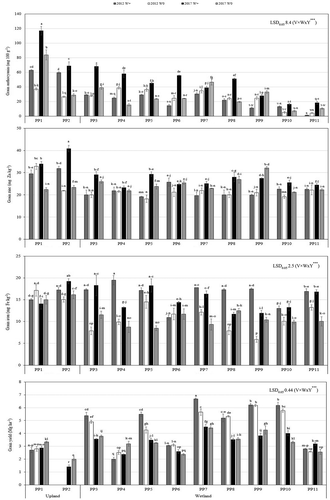
Figure 5. Comparison of anthocyanin, Zn and Fe concentration in brown rice and grain yield of 11 purple rice varieties growing under aerobic compared with wetland condition in two years. Each data point is mean of 3 biological replications
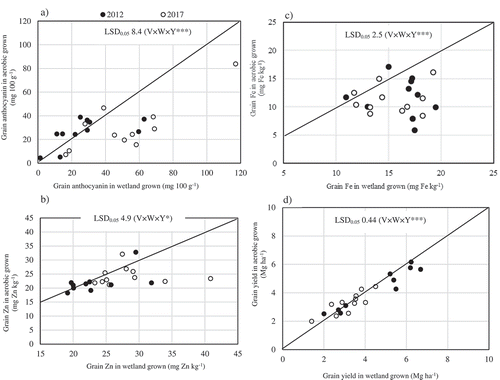
The grain Zn concentration was negatively associated with grain yield (r = −0.50, P ≤ 0.001), and positively with anthocyanin concentration (). The negative correlation between Zn and grain yield was found under wetland grown in 2012 (r = −0.64, P < 0.05) ()). The positive correlation between Zn and anthocyanin identified by wetland grown in 2012 (r = 0.66, P < 0.05) and 2017 (r = 0.60, P < 0.05) ()). There was no significant relationship between yield and anthocyanin or Fe concentration, neither were the association between anthocyanin and Fe ().
Table 5. Linear relationships between grain anthocyanin, Zn and Fe concentration and yield of 11 purple rice varieties grown in aerobic and wetland conditions in 2012 and 2017
Discussion
This experiment has shown that nutritional quality of purple rice was depressed when grown in the aerobic soil compared with the wetland soil in those varieties with higher grain anthocyanin, Zn and Fe concentration, while water had either negative or positive but much smaller effects on those varieties with lower nutritional quality (). The water regimes had minor effect on grain yield (). Soil water status is one of significant environmental variables influencing the synthesis of nutritional qualities in rice (Goufo & Trindade, Citation2017). There were studies pointing that the varying water management affecting on bioactive compounds in rice. Orasen et al. (Citation2019) reported that water regimes by alternate wetting and drying stimulated the biosynthesis of flavonoid in brown rice grain of non-pigment rice varieties comparing with continuous flooding. The 10-day interval water stress condition after transplanting affected to increase anthocyanin both in drought tolerant and sensitive varieties (Khan et al., Citation2017). A similar response was reported by Rayee et al. (Citation2018) reporting that anthocyanin in japonica and indica rice varieties greatly enhanced by the 3-day interval of water deficit after anthesis to harvest. However, the response of anthocyanin concentration to water condition is variable, depending on several key factors such as the degree of water restriction and microclimates (Esteban et al., Citation2001; He et al., Citation2010). In the present study, anthocyanin of almost purple rice varieties both upland and wetland ecotypes increased when grown the wetland condition in 2017 while in 2012, anthocyanin of more than half of purple varieties improved when grown in the aerobic condition (). Presumably, the microclimates variation between the 2 years had affected on grain anthocyanin in purple rice varieties differently between the water regimes.
Uptake of Zn and Fe by the rice plant is regulated by both soil and plant factors that can be altered by water regimes (Gao et al., Citation2012). Responses to soil Fe and Zn in the rice plant under different water regimes have been subjected to many reviews. Wetland cultivation creates the anaerobic soil environment which induces several chemical changes in the rhizosphere of rice. The main changes that occur in anaerobic rice soils are decreases in redox potential and the reduction of Fe3+ to Fe2+, resulting in increased Fe2+ uptake by the rice roots (Fageria et al., Citation2011, Citation2008; Ishimaru et al., Citation2006). The degree and magnitude of this chemical change are determined by soil type, soil organic matter, soil fertility, varieties, and microbial activities (Fageria et al., Citation2011). On the other hand, the conversion of wetland to upland conditions results in ferric Fe oxides to be gradually crystallized to less reactive forms (Takahashil et al., Citation1999). Fan et al. (Citation2012) reported that Fe concentration in the grain both in the wetland and upland rice varieties decreases after the shift from wetland to upland cultivation. The significantly higher grain Fe concentrations under the wetland than aerobic cultivation in more than a half of all purple rice varieties in both years of this experiment () might be explained in the same way. In contrast to Fe, the concentration and availability of Zn in soil decrease under wetland cultivation (Fageria et al., Citation2011) which might be associated with the precipitation of Zn sulfide or Zn carbonate in the bulk soil or to precipitation or sorption of Zn with Fe oxides in the rhizosphere at low redox potential in calcareous soil (Johnson-Beebout et al., Citation2009). In non-calcareous Zn, availability tends to be lower when continuously flooded than when well aerated (Impa & Johnson-Beebout, Citation2012). Translocation and accumulation of Fe and Zn into the rice grain, however, can differ from those in the vegetative plant parts. For non-pigmented or white rice, wetland culture produced unpolished rice with higher Zn concentration than aerobic culture, while the water regime had no effect on the grain Fe (Saenchai et al., Citation2016), the higher availability of Fe and lower availability of Zn in wetland soil notwithstanding. The concentration of grain Zn and Fe in Thailand’s mega varieties such as KDML105, RD6 and PPT1 grown under wetland conditions as their original ecotype was ranged from 17.3 to 25.8 mg Zn kg−1 and 6.3 to 14.1 mg Fe kg−1 in unpolished grain (Saenchai et al., Citation2012). In a similar growing condition, this study found that the purple rice varieties had higher the concentrations than those found in the above mega varieties (). The positive correlation between Zn and anthocyanin in wetland conditions found in this study ()) means that the health benefits from purple rice may be derived from both the higher Zn content as well as bioactivity of anthocyanin. Additionally, it has been reported that Zn could improve the stability of anthocyanin extraction and inhibit their degradation in purple corn (Luna-Vital et al., Citation2018). The negative association between yield and grain Zn concentration was found under wetland grown in 2012 (), suggesting dilution effects typical of local rice varieties as previously reported (Jaksomsak et al., Citation2017). However, there was no significant relationship between yield and anthocyanin or Fe concentration (). This would be great possibilities for improving grain nutrition in rice by breeding program and cultivation management without yield penalty.
In conclusion, the highest grain anthocyanin, Zn and Fe variety was respected to PP1, PP2 and PP4, grown under the wetland condition, but the condition had negative effect on grain yield. The nutritional quality in aerobic grown rice was lower than wetland grown among the varieties with higher levels of anthocyanin, Zn and Fe, with smaller effects of water among varieties in the lower quality ranges. This could be the practical method for purple rice cultivation to increase grain nutritional values. Health benefits from purple rice are derived from the micronutrients as well as bioactivity of anthocyanin, especially as grain anthocyanin and Zn concentration are positively correlated. The highest anthocyanin varieties, PP1 and PP2 could be recommended to Thai farmers and the health promoting compounds from these varieties would benefit for consumers by consuming as their staple food or supplement food products.
Disclosure statement
No potential conflict of interest was reported by the authors.
Additional information
Funding
References
- Abdel-Aal, E. S. M., & Hucl, P. (1999). A rapid method for quantifying total anthocyanins in blue aleurone and purple pericarp wheats. Cereal Chemistry, 76(3), 350–354. https://doi.org/10.1094/CCHEM.1999.76.3.350
- Allan, J. E. (1961). The determination of zinc in agricultural materials by atomic-absorption spectrophotometry. Analyst, 86(1025), 530–534. https://doi.org/10.1039/an9618600530
- Chen, X. Q., Nagao, N., Itani, T., & Irifune, K. (2012). Anti-oxidative analysis, and identification and quantification of anthocyanin pigments in different coloured rice. Food Chemistry, 135(4), 2783–2788. https://doi.org/10.1016/j.foodchem.2012.06.098
- Deng, G.-F., Xu, X.-R., Zhang, Y., Li, D., Gan, R.-Y., & Li, H.-B. (2013). Phenolic compounds and bioactivities of pigmented Rice. Critical Reviews in Food Science and Nutrition, 53(3), 296–306. https://doi.org/10.1080/10408398.2010.529624
- Esteban, M. A., Villanueva, M. J., & Lissarrague, J. R. (2001). Effect of irrigation on changes in the anthocyanin composition of the skin of cv Tempranillo (Vitis vinifera L) grape berries during ripening. Journal of the Science of Food and Agriculture, 8(4), 409–420. https://doi.org/10.1002/1097-0010(200103)81:4<409::AID-JSFA830>3.0.CO;2-H
- Fageria, N. K., Carvalho, G. D., Santos, A. B., Ferreira, E. P. B., & Knupp, A. M. (2011). Chemistry of lowland rice soils and nutrient availability. Communications in Soil Science and Plant Analysis, 42(16), 1913–1933. https://doi.org/10.1080/00103624.2011.591467
- Fageria, N. K., Santos, A. B., Barbosa Filho, M. P., & Guimaraes, C. M. (2008). Iron toxicity in lowland rice. Journal of Plant Nutrition, 31(9), 1676–1697. https://doi.org/10.1080/01904160802244902
- Fan, X. Y., Karim, M. R., Chen, X. P., Zhang, Y. Q., Gao, X. P., & Zhang, F. S. (2012). Growth and iron uptake of lowland and aerobic rice genotypes under flooded and aerobic cultivation. Communications in Soil Science and Plant Analysis, 43(13), 1811–1822. https://doi.org/10.1080/00103624.2012.684826
- Gao, X., Hoffland, E., Stomph, T., Grant, C. A., Zou, C., & Zhang, F. (2012). Improving zinc bioavailability in transition from flooded to aerobic rice. A review. Agronomy for Sustainable Development, 32, 465–478. doi: 10.1007/s13593-011-0053-x
- Goufo, P., & Trindade, H. (2017). Factors influencing antioxidant compounds in rice. Critical Reviews in Food Science and Nutrition, 57(5), 893–922. https://doi.org/10.1080/10408398.2014.922046
- He, F., Mu, L., Yan, G. L., Liang, N. N., Pan, Q. H., Wang, J., Reeves, M. J., & Duan, C. Q. (2010). Biosynthesis of anthocyanins and their regulation in colored grapes. Molecules (Basel, Switzerland), 15(12), 9057–9091. https://doi.org/10.3390/molecules15129057
- Hu, C., Zawistowski, J., Ling, W. H., & Kitts, D. D. (2003). Black rice (Oryza sativa L. indica) pigmented fraction suppresses both reactive oxygen species and nitric oxide in chemical and biological model systems. Journal of Agricultural and Food Chemistry, 51(18), 5271–5277. doi: 10.1021/jf034466n
- Impa, S. M., & Johnson-Beebout, S. E. (2012). Mitigating zinc deficiency and achieving high grain Zn in rice through integration of soil chemistry and plant physiology research. Plant and Soil, 361(1–2), 3–41. https://doi.org/s13593-011-0053-x/s11104-012-1315-3
- Ishimaru, Y., Suzuki, M., Tsukamoto, T., Suzuki, K., Nakazono, M., Kobayashi, T., Wada, Y., Watanabe, S., Matsuhashi, S., Takahashi, M., Nakanishi, H., Mori, S., & Nishizawa, N. K. (2006). Rice plants take up iron as an Fe 3+-phytosiderophore and as Fe2+. Plant Journal, 45(3), 335–346. https://doi.org/10.1111/j.1365-313X.2005.02624.x
- Ito, V. C., & Lacerda, L. G. (2019). Black rice (Oryza sativa L.): A review of its historical aspects, chemical composition, nutritional and functional properties, and applications and processing technologies. Food Chemistry, 301, 125304. https://doi.org/10.1016/j.foodchem.2019.125304
- Jaksomsak, P., Rerkasem, B., & Prom-u-thai, C. (2017). Responses of grain zinc and nitrogen concentration to nitrogen fertilizer application in rice varieties with high-yielding low-grain zinc and low-yielding high grain zinc concentration. Plant and Soil, 411(1–2), 101–109. https://doi.org/s13593-011-0053-x/s11104-016-3056-1
- Jaksomsak, P., Yimyam, N., Dell, B., Prom-u-thai, C., & Rerkasem, B. (2015). Variation of seed zinc in a local upland rice germplasm from Thailand. Plant Genetic Resources -characterization and Utilization, 13(2), 168–175. https://doi.org/10.1017/S1479262114000872
- Jamjod, S., Yimyam, N., Lordkaew, S., Prom-U-Thai, C., & Rerkasem, B. (2017). Characterization of on-farm rice germplasm in an area of the crop’s Center of diversity. Chiang Mai University Journal of Natural Science, 16(2), 85–98. doi: 10.12982/cmujns.2017.0007
- Johnson-Beebout, S. E., Lauren, J. G., & Duxbury, J. M. (2009). Immobilization of zinc fertilizer in flooded soils monitored by adapted DTPA soil test. Communications in Soil Science and Plant Analysis, 40(11–12), 1842–1861. https://doi.org/10.1080/00103620902896738
- Kaladee, D. (2011). Khao Kam (Niaw Dam), the neglected Thai rice resources. Chiang Mai University. (in Thai).
- Khan, F., Upreti, P., Singh, R., Shukla, P. K., & Shirke, P. A. (2017). Physiological performance of two contrasting rice varieties under water stress. Physiology and Molecular Biology of Plants, 23(1), 85–97. https://doi.org/10.1007/s12298-016-0399-2
- Konczak, I., & Zhang, W. (2004). Anthocyanins - More than nature’s colours. Journal of Biomedicine & Biotechnology, 5(5), 239–240. https://doi.org/10.1155/S1110724304407013
- Luna-Vital, D., Cortez, R., Ongkowijoyo, P., & de Mejia, E. G. (2018). Protection of color and chemical degradation of anthocyanin from purple corn (Zea mays L.) by zinc ions and alginate through chemical interaction in a beverage model. Food Research International, 105, 169–177. https://doi.org/10.1016/j.foodres.2017.11.009
- Moonnilta, P. (2010). Genetic diversity of local purple glutinous rice varieties [Master’s thesis]. Chiang Mai University, 1–100. (in Thai).
- Orasen, G., De Nisi, P., Lucchini, G., Abruzzese, A., Pesenti, M., Maghrebi, M., Kumar, A., Nocito, F. F., Baldoni, E., Morgutti, S., Negrini, N., Valè, G., & Sacchi, G. A. (2019). Continuous flooding or alternate wetting and drying differently affect the accumulation of health-promoting phytochemicals and minerals in rice brown grain. Agronomy, 9(10), 628. https://doi.org/10.3390/agronomy9100628
- Pengkumsri, N., Chaiyasut, C., Saenjum, C., Sirilun, S., Peerajan, S., Suwannalert, P., Sirisattha, S., & Sivamaruthi, B. S. (2015). Physicochemical and antioxidative properties of black, brown and red rice varieties of northern Thailand. Food Science and Technology, 35(2), 331–338. https://doi.org/10.1590/1678-457X.6573
- Pereira-Caro, G., Watanabe, S., Crozier, A., Fujimura, T., Yokota, T., & Ashihara, H. (2013). Phytochemical profile of a Japanese black-purple rice. Food Chemistry, 141(3), 2821–2827. https://doi.org/10.1016/j.foodchem.2013.05.100
- Pintasen, S., Prom-u-thai, C., Jamjod, S., Yimyam, N., & Rerkasem., B. (2007). Variation of grain iron content in a local upland rice germplasm from the village of Huai Tee Cha in northern Thailand. Euphytica, 158(1–2), 27–34. https://doi.org/10.1007/s10681-007-9421-7
- Rayee, R., Tran, H. D., Xuan, T. D., & Khanh, T. D. (2018). Imposed water deficit after anthesis for the improvement of macronutrients, quality, phytochemicals, and antioxidants in rice grain. Sustainability, 10(12), 4843. https://doi.org/10.3390/su10124843
- Saenchai, C., Prom-u-thai, C., Jamjod, S., Del, L. B., & Rerkasem, B. (2012). Genotypic variation in milling depression of iron and zinc concentration in rice grain. Plant and Soil, 361(1–2), 271–278. https://doi.org/10.1007/s11104-012-1228-1
- Saenchai, C., Prom-U-Thai, C., Lordkaew, S., Rouached, H., & Rerkasem, B. (2016). Distribution of iron and zinc in plant and grain of different rice genotypes grown under aerobic and wetland conditions. Journal of Cereal Science, 71, 108–115. https://doi.org/10.1016/j.jcs.2016.08.007
- Sompong, R., Siebenhandl-Ehn, S., Linsberger-Martin, G., & Berghofer, E. (2011). Physicochemical and antioxidative properties of red and black rice varieties from Thailand, China and Sri Lanka. Food Chemistry, 124(1), 132–140. https://doi.org/10.1016/j.foodchem.2010.05.115
- Takahashil, T., Park, C.-Y., Nakajima, H., Sekiya, H., & Toriyama, K. (1999). Ferric iron transformation in soils with rotation of irrigated rice-upland crops and effect on soil tillage properties. Soil Science and Plant Nutrition, 45(1), 163–173. https://doi.org/10.1080/00380768.1999.10409332
- Tanaka, J., Nakanishi, T., Ogawa, K., Tsuruma, K., Shimazawa, M., Shimoda, H., & Hara, H. (2011). Purple rice extract and anthocyanidins of the constituents protect against light-induced retinal damage in vitro and in vivo. Journal of Agricultural and Food Chemistry, 59(2), 528–536. https://doi.org/10.1021/jf103186a
- Vichapong, J., Sookserm, M., Srijesdaruk, V., Swatsitang, P., & Srijaranai, S. (2010). High performance liquid chromatographic analysis of phenolic compounds and their antioxidant activities in rice varieties. Lwt-Food Science and Technology, 43(9), 1325–1330. https://doi.org/10.1016/j.lwt.2010.05.007
- Wang, Y. Y., Wei, Y. Y., Dong, L. X., Lu, L. L., Feng, Y., & Zhang, J. (2014). Improved yield and Zn accumulation for rice grain by Zn fertilization and optimized water management. Journal of Zhejiang University-Science B, 15(4), 365–374. https://doi.org/10.1631/jzus.B1300263
- Xia, M., Ling, W. H., Ma, J., Kitts, D. D., & Zawistowski, J. (2003). Supplementation of diets with the black rice pigment fraction attenuates atherosclerotic plaque formation in apolipoprotein E deficient mice. Journal of Nutrition, 133(3), 744–751. https://doi.org/10.1093/jn/133.3.744
- Xu, Y. J., Gu, D. J., Li, K., Zhang, W. Y., Zhang, H., Wang, Z. Q., & Yang, J. (2019). Response of grain quality to alternate wetting and moderate soil drying irrigation in rice. Crop Science, 59(3), 1261–1272. https://doi.org/10.2135/cropsci2018.11.0700
- Yodmanee, S., Karrila, T., & Pakdeechanuan, P. (2011). Physical, chemical and antioxidant properties of pigmented rice grown in Southern Thailand. International Food Research Journal, 18(3), 901‒906.
- Zhang, M. W., Zhang, R. F., Zhang, F. X., & Liu, R. H. (2010). Phenolic profiles and antioxidant activity of black rice bran of different commercially available varieties. Journal of Agricultural and Food Chemistry, 58(13), 7580–7587. https://doi.org/10.1021/jf1007665
